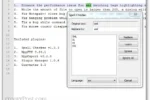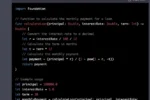Imagine finding ancient scrolls that have been hidden away for almost 2,000 years! That’s exactly what researchers are doing with the Herculaneum scrolls, which were buried by the eruption of Mount Vesuvius in 79 CE. Thanks to exciting new technology called artificial intelligence, scientists can now read these fragile texts without having to unwrap them. This amazing discovery not only helps us learn about the past but also shows how teamwork between libraries, computer experts, and historians can unlock secrets from long ago. Let’s dive into how this incredible process works!
| Attribute | Details |
|---|---|
| Title | AI Unlocks 2,000-Year-Old Herculaneum Scroll Carbonized by Vesuvius |
| Eruption Date | 79 CE |
| Location | Herculaneum, near Pompeii, Italy |
| Scroll Designation | PHerc. 172 |
| Discovery Year | 1750 |
| Research Institutions | University of Oxford, University of Kentucky |
| Technology Used | AI algorithms, X-ray tomography, computer vision |
| Notable Achievement | First word translated: Ancient Greek ‘διατροπή’ (disgust) |
| Recent Prize Winners | Luke Farritor won $40,000; Team won $700,000 in 2023 |
| Current Status | Last 26 lines detected; core contents still undeciphered |
| Significance | Collaboration of libraries, computer science, and humanities to uncover history |
Unlocking Ancient Texts with AI
Artificial intelligence is changing the way we explore the past, especially when it comes to ancient texts. Researchers are now able to read scrolls that were buried for nearly 2,000 years due to the eruption of Mount Vesuvius. These scrolls were carbonized, making traditional reading methods impossible. With AI, scientists can analyze the chemical differences in the ink and papyrus, allowing them to uncover the words hidden within these fragile artifacts.
One remarkable achievement in this field is the deciphering of scroll PHerc. 172, discovered in the ancient town of Herculaneum. Using advanced imaging techniques, researchers can create 3D models of the scrolls without unrolling or damaging them. As a result, they can identify ink patterns and eventually read the texts, bringing lost knowledge back to life and deepening our understanding of ancient Roman culture.
The Vesuvius Challenge: A Race Against Time
The Vesuvius Challenge is an exciting competition that brings together scholars and technology enthusiasts to translate ancient texts. Participants, like Luke Farritor, have the chance to win cash prizes for their discoveries. This challenge not only promotes research but also highlights the importance of collaboration between different fields, such as computer science and humanities. By encouraging teamwork, the challenge helps revive the voices of the past.
In 2023, Luke Farritor made headlines by translating the first word from an unopened scroll, earning $40,000 for his efforts. The Vesuvius Challenge has attracted significant attention and funding, emphasizing the value of preserving history through innovative technology. As more scrolls are examined, we can expect to discover even more about the lives of people who lived nearly two millennia ago, enriching our connection to history.
The Future of Archaeological Discoveries
The combination of artificial intelligence and modern imaging techniques is revolutionizing archaeology. As researchers continue to develop new methods to read ancient scrolls, we can anticipate a wave of discoveries that will reshape our understanding of historical events and cultures. The ability to digitally unwrap scrolls means we can study delicate artifacts without risking damage, opening up new avenues for exploration.
Looking ahead, the work done by the Vesuvius Challenge and its partners may inspire similar projects worldwide. As technology advances, archaeologists will likely uncover more lost texts and artifacts, allowing us to learn from civilizations long gone. Each new discovery not only adds to our knowledge but also reminds us of the importance of preserving our shared history for future generations.
The Technological Breakthrough in Reading Ancient Texts
The application of artificial intelligence to decipher ancient texts marks a significant advancement in the field of archaeology and historical research. Researchers are employing sophisticated algorithms that analyze the ink’s chemical properties against the carbonized papyrus background. This innovative technique allows scholars to read texts that have remained hidden for centuries without the risks associated with physically unwrapping delicate scrolls. It transforms how we approach ancient documents, making previously inaccessible knowledge available to modern scholars.
This technological breakthrough not only saves time but also preserves the integrity of fragile artifacts. By utilizing X-ray tomography to create 3D models of the scrolls, researchers can visualize the ink patterns with remarkable precision. This approach minimizes the risk of damage, which has historically plagued efforts to study carbonized scrolls. As a result, this method stands as a promising solution for future archaeological endeavors, as it can be applied to other historical documents that remain unreadable due to their condition.
The Role of AI in Archaeological Research
Artificial intelligence is revolutionizing the field of archaeology by enabling researchers to uncover and interpret ancient texts that would otherwise remain illegible. With the ability to process vast amounts of data rapidly, AI algorithms identify patterns and distinguish between ink and charred papyrus. This capability enhances our understanding of historical contexts and civilizations, offering insights into daily life, beliefs, and societal structures of ancient cultures.
Moreover, AI fosters collaboration among diverse fields, such as computer science, history, and linguistics, creating a multidisciplinary approach to research. The Vesuvius Challenge attracts professionals from various backgrounds, highlighting the importance of teamwork in unraveling the past. As these collaborations continue to grow, we can expect even greater advancements in the ways we interpret and appreciate our historical heritage.
Implications for Historical Scholarship
The successful deciphering of ancient texts using AI has profound implications for historical scholarship. It not only opens new avenues for research but also encourages a reevaluation of existing narratives about the past. As scholars gain access to previously unreadable works, our understanding of ancient societies, their philosophies, and their literature can be significantly enriched. This newfound knowledge can lead to fresh interpretations and a more nuanced understanding of historical events.
Additionally, the discovery of words and phrases from the Herculaneum scrolls, such as ‘διατροπή’ (disgust), prompts deeper inquiries into the emotional and cultural landscapes of ancient civilizations. As researchers continue to decode these texts, they may uncover references to significant historical figures or events, thereby enhancing our grasp of the interconnectedness of cultures and histories. This ongoing research underscores the importance of preserving and studying our antiquities as they provide invaluable insights into the human experience.
Future Prospects for AI-Driven Archaeology
The future of AI-driven archaeology looks promising, as ongoing advancements in machine learning and imaging technologies are expected to enhance the field further. Researchers envision a time when AI can assist in the discovery and analysis of archaeological sites, predicting where artifacts might be found based on historical data. This predictive capability could streamline excavations and significantly reduce resource expenditure while maximizing the yield of knowledge from each site.
Moreover, as AI algorithms become more sophisticated, they may be able to decipher not just carbonized texts but also inscriptions and other forms of ancient writing on various materials. The potential to recover lost knowledge from diverse historical contexts is immense, offering a rich tapestry of information about human civilization. As these technologies evolve, they promise to transform our understanding of history and foster a deeper appreciation of our shared cultural heritage.
Frequently Asked Questions
What is the Vesuvius Challenge and why is it important?
The **Vesuvius Challenge** is a competition that helps translate ancient scrolls buried by Mount Vesuvius. It’s important because it allows us to read texts that were lost for nearly **2,000 years**, revealing history.
How did the eruption of Mount Vesuvius affect Herculaneum?
When **Mount Vesuvius erupted** in 79 CE, it covered Herculaneum in **ash and debris**, destroying the town and preserving many objects, including scrolls, which are now rediscovered and studied.
What technology is used to read the carbonized scrolls?
Researchers use **X-ray tomography** and **computer vision** to create 3D images of the scrolls. This technology helps carefully ‘unwrap’ them digitally without causing damage.
Who helped find and translate the first word from a scroll?
**Luke Farritor**, a young researcher, discovered and translated the first word from an unopened scroll. His work won him a **$40,000 prize** and helped advance the project.
What does the word ‘disgust’ mean in Ancient Greek?
In Ancient Greek, the word ‘**διατροπή**’ means ‘disgust.’ It was one of the first words found in the translated texts from the scrolls.
Why is AI important in the study of ancient scrolls?
**AI** helps researchers read ancient scrolls without opening them. It uses smart algorithms to analyze the **ink patterns** and extract information, making the process faster and safer.
What is the significance of the scrolls found in Herculaneum?
The scrolls from Herculaneum are significant because they hold **ancient knowledge** and literature that can teach us about Roman life and thoughts from almost **2,000 years ago**.
Summary
Researchers at the University of Oxford and the Vesuvius Challenge have successfully deciphered a carbonized scroll, PHerc. 172, from Herculaneum, buried by the Mount Vesuvius eruption in 79 CE. Utilizing advanced AI algorithms, scholars can now read these fragile texts without unwrapping them, a process that involves X-ray tomography and computer vision. The project gained attention when Luke Farritor translated the first word from an unopened scroll, earning significant prizes. This collaboration exemplifies the intersection of libraries, computer science, and classical studies, revealing insights into ancient texts that have remained unread for nearly 2,000 years.







